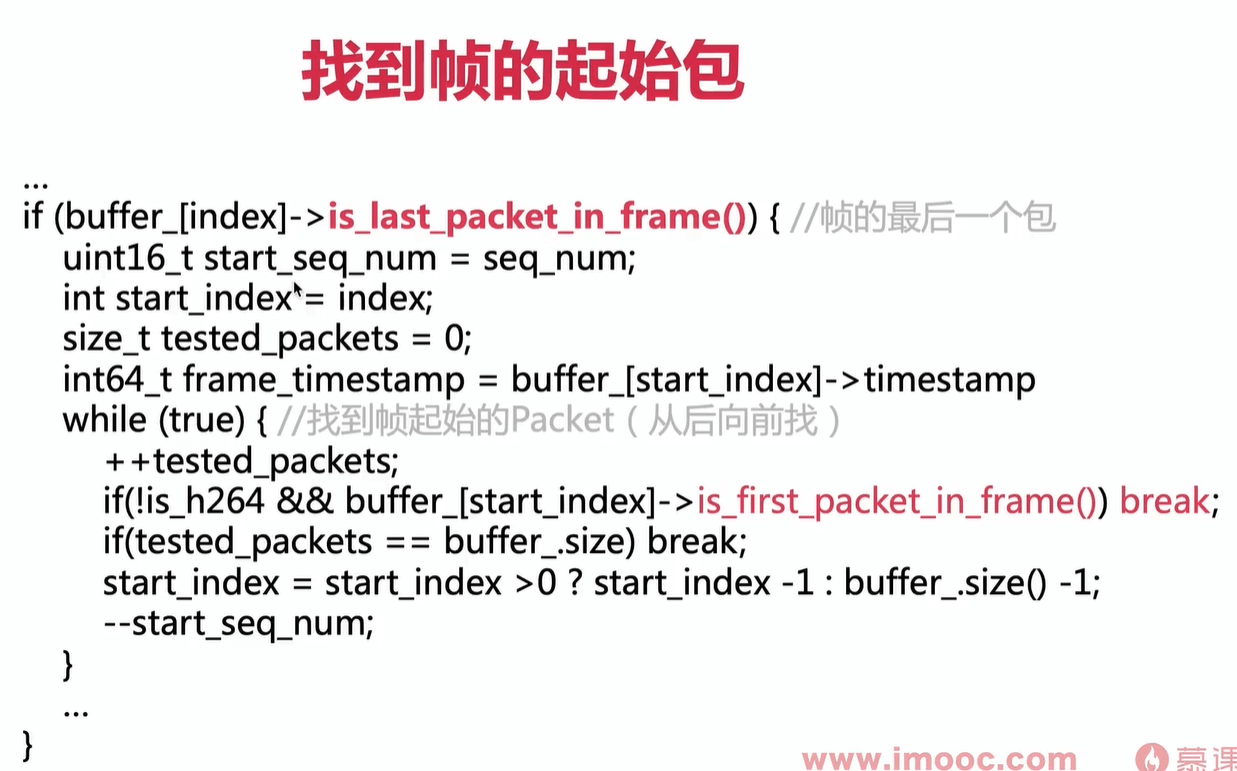找到潜在的新帧

1、获取当前包,和前面一个包
2、判断当前包是否为空,是否不存在,和是否是该帧的第一个包
3、判断前一个包是否存在(是否是连续包),前一个包跟当前包有没有关系seq_num,判断前一个包和当前包是否是在同一个帧。如果前面包是连续的,则可能存在新包。
找到帧的起始包
将属于同一帧的包都找出来

源码注释
std::vector<std::unique_ptr<PacketBuffer::Packet>> PacketBuffer::FindFrames(uint16_t seq_num) {std::vector<std::unique_ptr<PacketBuffer::Packet>> found_frames;for (size_t i = 0; i < buffer_.size() && PotentialNewFrame(seq_num); ++i) {// 获取该包在buffer_中的位置size_t index = seq_num % buffer_.size();buffer_[index]->continuous = true;// If all packets of the frame is continuous, find the first packet of the// frame and add all packets of the frame to the returned packets.// 判断这个包,是否是这个帧的最后一个包。if (buffer_[index]->is_last_packet_in_frame()) {uint16_t start_seq_num = seq_num;// Find the start index by searching backward until the packet with// the |frame_begin| flag is set.int start_index = index;size_t tested_packets = 0;int64_t frame_timestamp = buffer_[start_index]->timestamp;// Identify H.264 keyframes by means of SPS, PPS, and IDR.bool is_h264 = buffer_[start_index]->codec() == kVideoCodecH264;bool has_h264_sps = false;bool has_h264_pps = false;bool has_h264_idr = false;bool is_h264_keyframe = false;int idr_width = -1;int idr_height = -1;while (true) {++tested_packets;if (!is_h264 && buffer_[start_index]->is_first_packet_in_frame())break;if (is_h264) {const auto* h264_header = absl::get_if<RTPVideoHeaderH264>(&buffer_[start_index]->video_header.video_type_header);if (!h264_header || h264_header->nalus_length >= kMaxNalusPerPacket)return found_frames;for (size_t j = 0; j < h264_header->nalus_length; ++j) {if (h264_header->nalus[j].type == H264::NaluType::kSps) {has_h264_sps = true;} else if (h264_header->nalus[j].type == H264::NaluType::kPps) {has_h264_pps = true;} else if (h264_header->nalus[j].type == H264::NaluType::kIdr) {has_h264_idr = true;}}if ((sps_pps_idr_is_h264_keyframe_ && has_h264_idr && has_h264_sps &&has_h264_pps) ||(!sps_pps_idr_is_h264_keyframe_ && has_h264_idr)) {is_h264_keyframe = true;// Store the resolution of key frame which is the packet with// smallest index and valid resolution; typically its IDR or SPS// packet; there may be packet preceeding this packet, IDR's// resolution will be applied to them.if (buffer_[start_index]->width() > 0 &&buffer_[start_index]->height() > 0) {idr_width = buffer_[start_index]->width();idr_height = buffer_[start_index]->height();}}}if (tested_packets == buffer_.size())break;start_index = start_index > 0 ? start_index - 1 : buffer_.size() - 1;// In the case of H264 we don't have a frame_begin bit (yes,// |frame_begin| might be set to true but that is a lie). So instead// we traverese backwards as long as we have a previous packet and// the timestamp of that packet is the same as this one. This may cause// the PacketBuffer to hand out incomplete frames.// See: https://bugs.chromium.org/p/webrtc/issues/detail?id=7106if (is_h264 && (buffer_[start_index] == nullptr ||buffer_[start_index]->timestamp != frame_timestamp)) {break;}--start_seq_num;}if (is_h264) {// Warn if this is an unsafe frame.if (has_h264_idr && (!has_h264_sps || !has_h264_pps)) {RTC_LOG(LS_WARNING)<< "Received H.264-IDR frame ""(SPS: "<< has_h264_sps << ", PPS: " << has_h264_pps << "). Treating as "<< (sps_pps_idr_is_h264_keyframe_ ? "delta" : "key")<< " frame since WebRTC-SpsPpsIdrIsH264Keyframe is "<< (sps_pps_idr_is_h264_keyframe_ ? "enabled." : "disabled");}// Now that we have decided whether to treat this frame as a key frame// or delta frame in the frame buffer, we update the field that// determines if the RtpFrameObject is a key frame or delta frame.const size_t first_packet_index = start_seq_num % buffer_.size();if (is_h264_keyframe) {buffer_[first_packet_index]->video_header.frame_type =VideoFrameType::kVideoFrameKey;if (idr_width > 0 && idr_height > 0) {// IDR frame was finalized and we have the correct resolution for// IDR; update first packet to have same resolution as IDR.buffer_[first_packet_index]->video_header.width = idr_width;buffer_[first_packet_index]->video_header.height = idr_height;}} else {buffer_[first_packet_index]->video_header.frame_type =VideoFrameType::kVideoFrameDelta;}// If this is not a keyframe, make sure there are no gaps in the packet// sequence numbers up until this point.if (!is_h264_keyframe && missing_packets_.upper_bound(start_seq_num) !=missing_packets_.begin()) {return found_frames;}}const uint16_t end_seq_num = seq_num + 1;// Use uint16_t type to handle sequence number wrap around case.uint16_t num_packets = end_seq_num - start_seq_num;found_frames.reserve(found_frames.size() + num_packets);for (uint16_t i = start_seq_num; i != end_seq_num; ++i) {std::unique_ptr<Packet>& packet = buffer_[i % buffer_.size()];RTC_DCHECK(packet);RTC_DCHECK_EQ(i, packet->seq_num);// Ensure frame boundary flags are properly set.packet->video_header.is_first_packet_in_frame = (i == start_seq_num);packet->video_header.is_last_packet_in_frame = (i == seq_num);found_frames.push_back(std::move(packet));}missing_packets_.erase(missing_packets_.begin(),missing_packets_.upper_bound(seq_num));}++seq_num;}return found_frames;}



